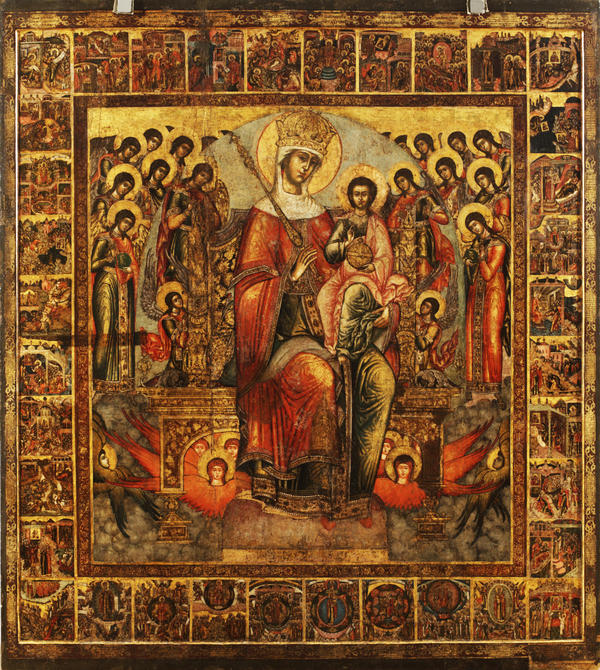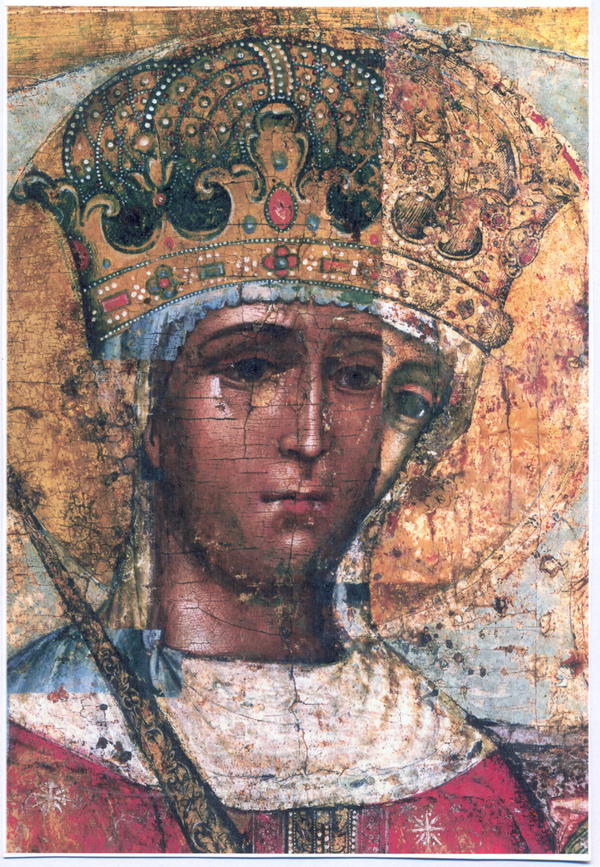Virgin Mary is painted on the icon as the Queen of Heaven. In its central part, the center piece, there is crowned Virgin Mary on the throne with the Child on her left hand. Virgin Mary is holding the scepter and Christ is holding the orb. Behind the throne, there are angels, two of which are holding mirror plates, i.e. transparent spheres with Christ’s initials.
1 / 2
Holy Mother on the Throne
Время создания
1680-ies
Размер
194x171 cm
Техника
Tempera
Коллекция
Выставка
3
Открыть в приложении#4
Unknown author
Holy Mother on the Throne
#7
#8
Descriptiveness was typical for the Yaroslavl icon painting of the late 17th century: many images were complicated and of a multi-story character. 36 miniature hallmarks on this icon are devoted to Virgin Mary’s life in this world, events and miracles, related to her, as well and prophecies. In the bottom line there are illustrations to psalms in honour of the Holy Virgin.
#9
The majority of plots, which are depicted on the hallmarks, are borrowed from the ‘New Heaven’ essay by Ioannicius Galyatovskiy. Based on different sources, this spiritual writer collected about 450 stories about Virgin Mary and grouped them on several themes, i.e. ‘Miracles of Virgin Mary from her Images’, ‘Miracles of the Iberian Icon of the Mother of God’ and many others. The book was first published in Lvov in the middle of the 17th century.
#10
The essay used to be a very good source of plots for many Russian icon painters, and some of the stories became extremely popular among the artists. For instance, the story about Saint Herman, who, as a boy, saw in a church an icon of the Mother of God with the baby Christ in her arms. However, the Child in the image was as realistic as the boy himself: so Herman extended his hand with an apple to the Child, and the latter took it. This naive and touching plot is found in other works of Yaroslavl church painting.
#11
The icon used to be in the John the Forerunner Church in the Tolchkovskaya Sloboda of Yaroslavl. The image is painted on a board of three parts, fastened with two dowels. It was created by local Yaroslavl craftsmen. This flavor is typical for the Yaroslavl icon painting of the second half of the 17th century: it has saturated red and green colours and plenty of gold on the background. The painters followed the patterns of the creative work of Semen Spiridonov from the town of Kholmogory, who used to visit Yaroslavl in 1670–1680-ies and worked there.
#5
The central part of the icon was completely opened in the Grabar All-Russia Art Research and Restoration Centre. This term implies cleansing from old coatings and extra paintings to the original author’s image. The hallmarks are preserved in a bit worse conditions, so they were opened only partially.
Photograph from N.G. Pervukhin’s book Church of John the Forerunner in Yaroslavl, 1913.
#6
Virgin Mary’s image. Fragment of the icon in the process of restoration.
The work of art used to be under restoration for nearly 40 years with intervals. Specialists gradually gave back its original appearance to the image. Most of all the change was visible in Virgin Mary’s image: it turned out to be that her head was straight on a later repainting while on the original one the head of the Mother of God was a bit tilted towards the Child.
#12
Yaroslavl Museum Reserve
читать дальшескрыть
00:00
00:00
1x
Holy Mother on the Throne
Время создания
1680-ies
Размер
194x171 cm
Техника
Tempera
Коллекция
Выставка
3
Открыть в приложении
Поделиться






